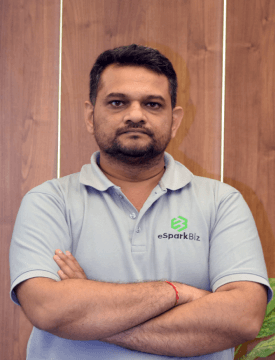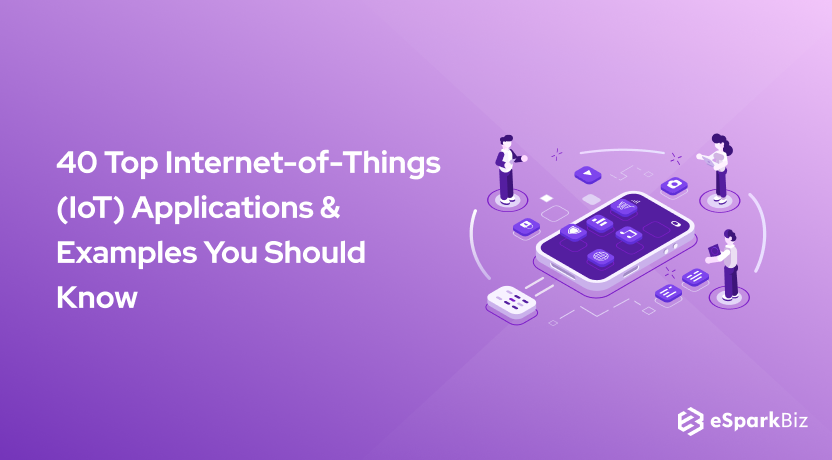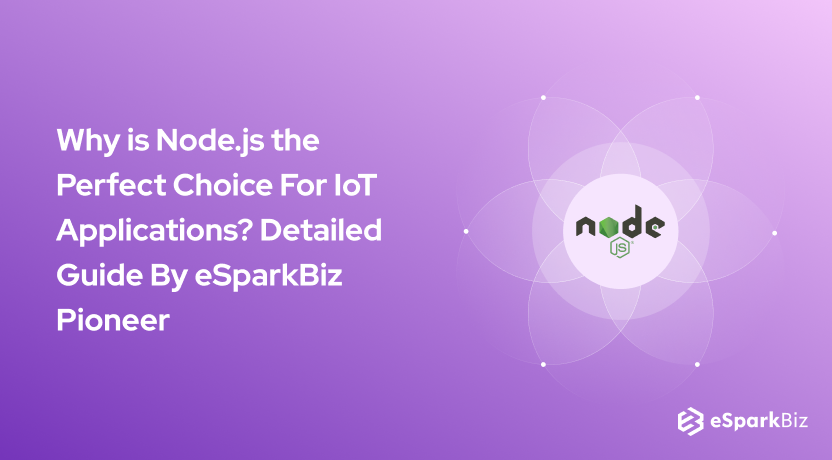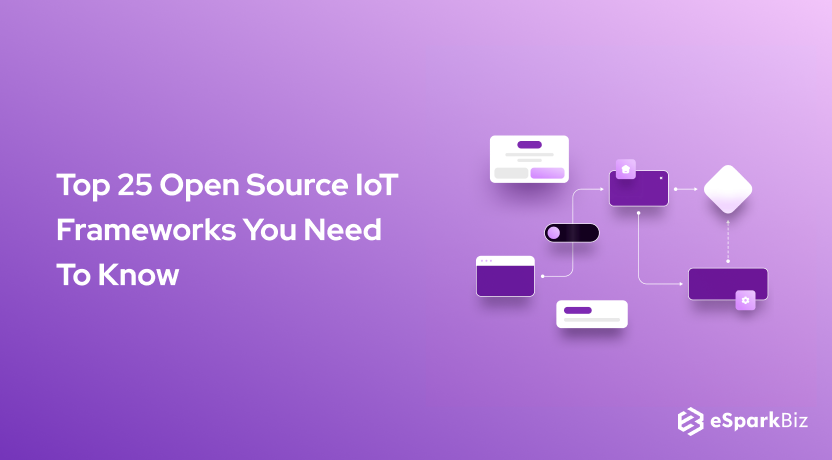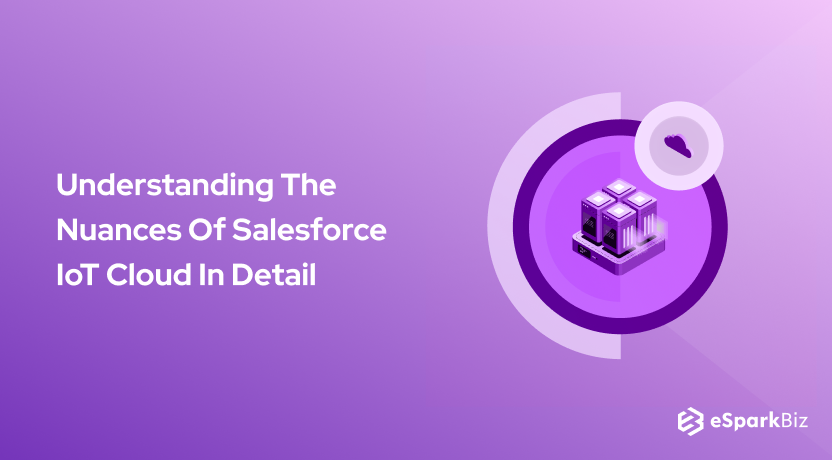Internet of Things or IoT is a buzzword in the tech space that inevitably comes up when there is a discussion about the technology of tomorrow. Today, we will talk about the Internet of Things Examples and IoT Applications in detail.
However, the way we describe IoT as something that is yet to make its entry in human life needs some rethinking.
Perhaps, we need to understand the fact that IoT is here, and it is actively changing the way we live. It also has shaped our decision-making habits.
On one hand, the internet changed the way humans communicate with each other, while on the other hand, IoT focuses on creating a communication flow between machines. Much like allowing equipment to talk to each other and share information with the help of sensors.
If the Internet was a revolution of the 20th century, IoT is the revolution of the 21st century.
We are in the moment where IoT is changing the technological approach, so hire dedicated development team to cope up with this technology stack and start implementing it in the projects to achieve futuristic solutions.
Noteworthy Internet of Things Applications & Examples
IoT Sensors
IoT sensors are a crucial cog that allows the collection and transmission of data amidst a network of devices. It is one of the finest Internet of Things Examples.
Generally, a sensor can be classified in different ways but the most common form of classification is active or passive sensors. You can also categorize them as an analog and digital sensors.
The IoT sensors are coupled with the circuit boards, which are programmed to collect various types of data.
Usually, two of the popular boards which are connected to sensors, today, include Arduino Uno and Raspberry Pi 2.
Arduino circuit board is most commonly used in both analog and digital sensors. Raspberry Pi 2 is one of the versions of the same, and each of them has its operating system with its core in Linux.
IoT Data Analytics
Data, the currency of information, is put into great use with the combination of IoT softwares and Data Analytics.
This powerful combination helps to work through huge volumes of data gathered through a connected network of devices to gain actionable insights.
The data revolution has brought new innovative solutions into the scene to store large volumes of data with minimum cost, and maximum efficiency.
With the availability of better data analytics tools, it is easier to make sense of any form of data regardless of the intricacies of structure.
Data analytics powered with the Internet of Things software solutions has brought a paradigm shift in some of the crucial sectors- like Manufacturing, Retail, and Healthcare- operating in a bid to scale and grow.
IoT Tracking and Monitoring System
Imagine how tedious it would be to track movements of team members across a large facility, or for that matter keeping track of assets that can be placed anywhere on the facility.
Now, think of the ease that the use of GPS can bring into the tracking system. Here, we are essentially talking about smart devices acting as GPS.
The IoT tracking and monitoring system is one of the fine IoT applications that uses a combination of transmitters and receivers to track asset movement. The entire data of asset movement can be accessed through the IoT online gateway.
IoT Connected Factory
Factories often work under predetermined targets, where they need to roll out a certain quantity of output to meet the growing demands.
In advanced production facilities, manual labor cannot meet the pace or scale of production.
So, in such cases, the production process is automated with bots. These bots are essentially devices that streamline the production process to meet huge industrial demands.
Any dip in the pace of production can have serious repercussions. So, today production facilities are equipped with the power of IoT, which brings forth real-time data.
The analysis of the data gathered can help to track any deviation in performance parameters, and timely remove the glitch so that the production process is not hampered.
Today, Microsoft Azure IoT connected factory solutions are employed increasingly due to the wide range of benefits that it brings to the fore. It is one of the classic IoT Examples.
Smart Supply Chain Management
Smart Supply Chain Management showcases the power of digitizing the process of movement of assets/stocks, pure manufactured products, through various stages.
The physical act of transfers remains the same, but it is the smart sensors attached to these products that help to easily monitor the movement in real-time.
The data gathered from the normal supply chain management process helps to assess the potential of the management system applied.
If things go haywire, an analysis of data provides a cause for the mishap. Thus, the supply chain managers can work on the issues, and avoid any such supply chain issues in the near future.
Smart Barcode Readers
Smart Barcode readers help to keep the track of inventory for a retailer.
However, the use of AI-based barcode readers is not just limited to the retail sector. It can also be used in warehouses and manufacturing facilities to keep the track of stocks.
Once, the product is passed through the bar code scanner and the final purchase is made, the removal of the product form the stock listing is shown in the computers.
The automation of the update process saves a lot of manual effort and time. It also simplifies the checkout process for IoT applications.
Smart Grids
Smart grids leverage the power of IoT applications to meet the changing electricity requirements in the 21st century.
The grids built previously were used for localized transmission of electricity. But today the grid operators have to serve more than just a locality.
The addition of IoT technology in the grid helps the engineers to accumulate necessary data regarding power consumption.
This information can help in channelizing the flow of electricity to the homes. So, the pressure to create more electric power during peak consumption hours can be distributed.
With IoT driven electric meters and submeters, the utility company can guide households about their pattern of power consumption, and how they reduce dependence on electricity.
Connected HealthCare System
Internet of Medical Things or IoMT is a healthcare based interpretation of IoT. Imagine your health vitals are stored online, and a physician is assigned to monitor your vitals throughout the day.
For instance, if the doctor finds any deviation signs in your vitals like BP fluctuation, erratic heartbeat rate, they can immediately contact you or your family member. This would give doctors the extra few minutes to prevent that fatal heart attack.
The future of healthcare seems very promising with the involvement of IoT. The inclusion of such technologies can help immensely in researching cures, by gathering data seamlessly and analyzing them to form a comprehensive report.
Today with the use of IoT applications, a farmer can practically assess the right time to harvest. Further, they can work through weather data gathered from relevant sensors and make predictions of rainfall accordingly.
Some of the IoT tools also provide a lot of important information about the nature of the soil and its composition. This helps the farmers to harvest crops that best fit the soil properties.
Smart Home
Living in a house with connected devices is living in a Smart Home. Quite often we forget to switch off the lights and fans. This is one of the finest IoT Examples.
Most of the time we return home after a busy day at the office to see that the fans and lights are on.
Imagine the amount of energy wasted, and the extra cost that you have to pay for the futile consumption of power.
IoT is changing the way we interact with our homes, as you can control the majority of the home appliances right from your smartphone.
So, next time when you leave the home and forget to switch off the electrical appliances, just take out your smartphone and save power & money.
Wearables
Fashion and accessories industries have seen a series of fads arrive and exit. But this time around wearables seems to have the potential to alter the course of the accessory, fashion, & fitness industry.
Wearables aided with modern technology like IoT are fast becoming products that transcend across different segments of the consumer class. This is one of the classic Internet of Things Examples that you will ever see.
Be it a youngster or an elderly person, you will find them wearing a fitness band. These small fashionable devices are laced with sensors that collect real-time health data.
Connected Cars
Many believe connected cars are a thing of the future, but we are seeing the glimpses of it today. This is one the classic IoT Applications.
The tech and automobile giants are collaborating with the intent to share innovative ideas to create connected cars that exceed the novelty factor and become normalcy.
In a connected car system, your device in the car gets automatically connected to your phone to such a degree that you can start the car using the smartphone.
You can check tire pressure through your smartphone. You can even open the garage door using the smartphone.
Isn’t the idea of a connected car fascinating?
Industrial Internet
The Industrial Internet is a vast network of interconnected devices that are led by modern technologies like AI, IoT, and ML. Here, we will focus on the IoT part of industry internet or IIOT (Industrial Internet of Things).
When the devices are interconnected through a virtual network that allows the transmission of data through sensors, we truly achieve a cohesive work setup.
In such working facilities, the production process is augmented through continuous scanning of data to find problems and solving them in the nick of time.
The IIoT brings in a host of benefits to every part of the industrial wheel. Be it quality assessment in the production facilities or inventory management or supply chain management at a macro level.
Smart Cities
When you search on the web- ‘What are examples of the Internet of Things?’ The first result that might appear is Smart Cities.
From Smart Homes to Smart Cities, IoT has the potential to transform the way we live, consume energy, preserve the environment, and a lot more.
Imagine cities being monitored through real-time footage, and traffic update sent through the sensors attached to the roadside CCTV camera. We would probably get rid of the traffic congestion problem permanently.
Further, with the effective waste management plan led by IoT devices, the cities would be cleaner and more hospitable. Energy conservation is yet another crucial benefit that comes handy in creating Smart Cities.
IoT In Agriculture
We have come a long way ahead post the agricultural revolution. But farmers seemed to be content with traditional agricultural practices with a slight modification here and there.
However, it is the introduction of IoT that is truly revolutionizing agricultural practices in modern times through the power of data.
With the increased availability of data related to agricultural practices, farmers now have a better understanding of the farming practices that can increase output based on the soil nutrient composition, and weather conditions.
Smart Retail
With e-commerce threatening to trigger a retail apocalypse, the need for new and innovative technologies in the world of retail has become a necessity.
As the online marketplace tracks every move of the customers and suggests products. A similar form of retail technology is needed now more than ever before.
The application of IoT in the retail sector is changing the way people view a retail store. Moreover, the retail business process has also changed drastically to bring in new technology.
Now, with IoT, the store owners can communicate with the consumers based on insights gathered from data analysis.
Even with the IoT, the course of customer paths along the retail store can be mapped, and products can be placed accordingly to attract consumers.
Energy Management
We have already skimmed through the idea of energy management in the smart cities section. Here, we will have a closer look at how IoT helps in managing energy resources and consumption.
Energy management with IoT involves a smart grid that allows for the grid operators to collect information regarding household power consumption.
After analyzing the information, the operators provide input to the household, as to how they can conserve energy through the use of solar panels, and other sources of electrical energy.
Elderly Care Monitoring
Elderly care is one such true benefit of IoT applications that have made the lives of many 60 plus individuals happier and peaceful.
BeClose is a company based in Virginia that collects real-time information about elderly people’s health and routine activities.
In case of any issue, the company alerts the professional caregivers or family members in the emergency contact list.
A BeClose button is placed in the home of the elderly individuals as an emergency feature that can be used in case of any serious issue comes up.
Smart Helmet
We can only imagine how many lives could have been saved, only if timely medical attention was available for individuals with head injuries.
We often hear that the application of technology should be purpose-driven, IoT embodies that philosophy. Explore IoT Examples that will help you to understand this logic.
Now, it is possible to provide timely medical assistance, with the ICEdot Crash sensor. This type of sensor connects the helmets with the smartphone using Bluetooth.
As the helmet hits the pavement, the sensors detect the motion and start a 30 seconds countdown. If you have a minor injury and you get up, you can stop the countdown.
But if you have a serious injury, after the 30-second countdown, your medical information along with GPS coordinates is sent to your emergency contact number.
RFID Smart Gun
Guns and the Internet are not combinations of two words that are often used. Interestingly, the National Institution of Justice has been channeling ten of millions in gun safety research.
The existence of RFID and biometric sensors are quite prevalent, but adding these components into firearms safety application is a different ball game altogether.
The German manufacturer, Armatix recently developed a handgun, which is paired with an RFID enabled watch.
The user can activate or deactivate the weapon by entering a PIN on the watch. Also, the handgun is rendered inactive, if it is taken 15 inches away from the watch.
Various other companies are trying to bring in technology-driven changes in gun safety. It’s just about the time when the people begin to accept new model guns citing reliability and safety.
Smart Sensor Racquet
Babolat, in partnership with Movea, has developed a unique racquet- Babolat Racquet- it utilizes the MEMS technology to record the game details of a player.
It can gather data about the type of shot types, the spin and pace generated through the shot, the grip pressure, and more such information. One of the finest Internet of Things Examples you will ever see.
Although the use of such racquet is disallowed in the professional circuit, coaches regularly use Babolat Racquet to gather information about how a particular player is performing, and what are the areas that need improvement.
Connected WiFi Typewriter
Being a writer in this 21st century means you ditch the old typewriter and work on laptops. But with an internet connection, you write less, as the distractions are simply too many.
A writing process is one that requires a lot of focus and adhering to strict deadlines. Such important prerequisites of writing take a backseat when you work on a laptop.
For solving this issue, we have a 21st-century wi-fi enabled typewriter that keeps you on the money and does not let your focus swing away. The wi-fi option is limited to accessing just Google Docs, or Evernote for editing.
Now, you can enjoy the clickety-clackety sound with features like real-time word count checker, and display of time spent on writing.
Air Quality Sensors
With rising CO2 and other greenhouse gas emissions, air pollution is soaring, thus it becomes essential to trace the quality of air that you inhale.
Tzoa, one of its kind wearable that helps to detect the quality of air through the path covered by a person. The LED display in the wearable provides information about the quality of the air in a color-coded scheme.
It detects two forms of air pollutants or particulate matter ie PM (PM10 and 2.5). The PM10 particulates are pollens that can cause allergen, while the PM2.5 are pollutants that can come out of the car exhaust.
When you are out in the sun, Toza also provides information about the UV levels that you are exposed to.
The detailed information about air quality and UV light exposure can be attained through the smartphone app.
Soil Monitoring
What lies deep in the oceans is as much a mystery, as the activities that take place beneath the earth’s surface.
As the new man-made structures are coming up at a rapid pace, the earth’s soil surface has been exposed to considerable alterations. Thus, it has become tough to ask to keep track of soil movements,
Geologists face a lot of difficulty in monitoring the real-time movement of soil and tracking the changes.
However, things are getting better with the introduction of products like Geo- Detect that uses fiber optic cables laid down through the entire construction site.
GeoDetect reduces uncertainty and helps in the timely completion of the project along with maintaining the safety standards.
Activity Trackers
The Activity Trackers are essentially sensor-based devices that are worn through the day, and it gives you real-time information about the level of fatigue, oxygen level, BP, and other health-related information.
With access to such on a real-time basis, you avoid some of the serious health issues and reduce the number of visits to the doctors. The activity trackers make you independent in away, and it is a perfect device for the elderly and differently-abled people.
Digital Twins
Think of digital twins as virtual cloning of physical objects. With the availability of technologies like AI, ML, and IoT, it has become easier to replicate the changes of physical objects to its digital twin.
Moreso, the virtual clones are automatically updated as any changes are introduced into the physical object concerning its surroundings.
This technology can save both time and money, as it eliminates the need to create a physical replica of an existing object for testing purposes.
Self Healing Machines
Self Healing Machines, a concept that is the result of 21st-century technological progress. It’s one of the great IoT Applications.
Today, machines and robots operating in large production facilities can self assess the minor hiccups and adjust the variations. To put it simply- self-heal.
Now, one can only imagine the amount of money that can be saved in repairs, and the extent to which the downtimes can be reduced.
Also, the need for manual inspection of such machines will be minimal, so the labor can be utilized in other productive areas.
AR Glasses
We have only seen screens appearing on the eyeglass in Hollywood sci-fi movies. But interestingly, these have become part of reality which are shown in the movies with a touch of creative liberation.
Today, we have Google Glasses that display various internet applications like Google Maps, and Gmail in the lenses.
It is a hands-free experience of using a lightweight computer. The lenses can also live stream videos of experts through the wi-fi network.
Ingestible Sensors
Ingestible sensors are the size of a pill, which has a power source, controller microprocessor, and most importantly sensors. These pills provide important information about the biological state of inner organs.
The ingestible pills provide crucial information about the disease, which helps the doctors to employ the right treatment at each stage.
Abilify MyCite is the first such pill that the U.S. Food and Drug Administration approved.
Smart Contact Lens
Rapid development made in the field of sensor-based contact lenses, which can provide health information.
At the same time, they provide information about the condition of the eyes. Doctors can use this information to predict various conditions like Glaucoma.
The testimony to the development pace is the sensor-based silicon contact lens that Swiss company Sensimed manufactures.
The sensor in the lenses transmits data wirelessly using the antenna that placed around the eye along with optical gear.
Motion Detection
Motion detectors can gauge the seismic motion and warn the engineers about the probable earthquake that, otherwise, could cause a lot of damage.
These detectors gauge the vibration of the buildings, dams, and other man-made towering structures.
In hilly areas, a series of such sensors can help to predict avalanches and landslides.
For a long time we had a hard time with natural disasters, but today with the power of technology, we can predict and prepare for it.
Driverless Cars
Many of you might have heard about the promising future of automobiles with a shift to electric power terrain, and driverless cars.
Yes, these avatars of automobiles are here already. They may be in a prototype stage, but that is promising enough to get car lovers excited.
With IoT, AI, and ML, these driverless cars trained to take you to your destinations. They can sense the traffic loads and maneuver directions.
These cars can take sharp turns while changing lanes, without interrupting the path of the nearby cars.
Some of the well-known automobile players who invested heavily in driverless cars include Tesla, BMW, Volkswagen, and Volvo.
According to a report, the German automaker VW has invested $54.2bn in technology development of driverless and electric cars.
Amazon Go
Amazon Go seems to be on a different race, the technological leaps with this company have taken over the years is astounding.
This time around it was the turn of IoT, which the global giant is using to transform the retail experience.
The future of brick and mortar stores with no cash counter, and salesperson. So how does this work?
Well, simply, the products coupled with sensors, so when you pick a product, it automatically added to the cart.
Further, when you keep the product back, you can remove it from the cart. The payment for products added to the cart is through the Amazon account.
The future business process of retail stores is simple yet effective.
Smart Hotel Rooms
The hospitality industry is also moving towards technology-driven solutions to enhance user experience. Hotel chains like Hilton are looking into IoT Applications to enhance the experience of the guests.
With the data gathered from the guest visits in different instances, the light and heating system of rooms can be tweaked for a personalized experience.
Further, the card keys substituted with smartphone apps, which is fascinating to say the least, as many a time we forget card keys, or lock ourselves out.
Smart Parking
Finding parking spaces in crowded areas is tough. Many times you need to park away from the designated spots, which invites parking fines. So, let us see how IoT can help us solve this daily life problem.
The IoT powered smart parking provides real-time information to the driver about the available spaces to park. It is one of the classic examples of Internet of Things.
The sensors transmit the information about the availability of the parking to the cloud server. You can access this information through smartphones.
raffic Management
Traffic Jams are not pain-inducing things for Asian countries. Some of the developed economies also face traffic management issues.
According to a report, traffic congestion causes an average American to lose 99 hours yearly, which can be translated to $1,400 per year.
The IoT enabled smart traffic monitoring can help the concerned authorities to manage the traffic in a better way.
They can also automatically change the signal lights and divert traffic to less congested routes. These are just a few ways in which IoT can help to manage traffic.
Smart Transportation
Smart Transportation management becomes crucial for organizations with tedious logistical requirements. This is one of the classic examples of IoT.
Involving drone delivery, computers, cameras for monitoring and location sensors, can make the fleet management a much more simplified process.
The operators can check the route of the vehicle and through geofencing, they can restrict vehicle movements. This can reduce the time of delivery, and the extra expenditure on fuels.
Companies can also track the vehicle and its driver throughout the journey, and if they find anything odd they can inform the fleet manager on the field. This can prevent accidents and production losses.
Read also: Top 25 Open Source IoT Frameworks You Need To Know
Smart Thermostats
It makes the act of regulating home temperature a cakewalk. You can control your home temperature through your smartphone.
As you are about to enter the room, simply open the mobile app, and adjust the thermal levels. Thus, when you are in the room there is an automatic adjustment of temperature levels according to your comfort.
One of the prominent examples of smart thermostats is the Nest Learning Thermostat, a Google-based product, which smartly adjusts your room temperature. It detects thermal patterns throughout the day and functions accordingly.
Smart Refrigerator
Remember the Carnegie Melon refrigerator based IoT application? Seems that it was not just the college kids, but normal households also need smart refrigerators.
These refrigerators not only provide information about the empty bottles, and finished diet cans, but also provide reminders of the placing order online for items that you do not have stock of.
Such refrigerators currently are not bought on a large scale, but as the technology is improving and the cost goes down, people will love to own one of them.
Google Glass
When talking about innovation, we cannot forget the innovative tech giant- Google. It is one of the leaders when you talk about Internet of Things Examples.
The tech behemoth has redefined the way we live our lives form Google Maps to Google Docs, and they provide something for all.
One of its promising offerings: Google Glass transports you to the future of computing. These optical headgears have lenses attached with sensors that activate with a voice command.
You can perform plenty of computing activities like browsing through the internet, accessing Google Maps, clicking pictures, and much more.
Seems unreal right? But this is the result of Googles ‘Project Glass’.
A Brief Background of IoT
In the early 1970s and 80s, the topic of communication between technological applications was spared for the conversation of knuckleheads.
Interestingly, it was in 1999 that the term IoT was first used by Kevin Ashton, a part of the P & G team.
The first practical application on the lines of IoT can be traced back to the 1980s at Carnegie Melon University.
Here, a bunch of local programmers connected the refrigerated appliances (Coca-Cola Machine) through the internet. They could monitor the availability of the cold drink, and then make plans to physically visit the spot.
Post-2010, two important events that marked the arrival of IoT include a Google acquisition and IDC report on IoT 2020.
It was in 2013, that IDC (International Data Corporation) estimated in a report that by 2020, IoT was going to be an $8.9 trillion market.
Here we are today in 2024, a time where with every passing second nearly 127 new IoT devices are connected to the internet.
Further in the Year 2014, as Google acquired Nest, the road to IoTisation of the tech economy was quite apparent, and that it was just a matter of a few years.
Today in 2024, we have numerous examples of the Internet of Things applications which shows that IoT has arrived and is here to stay.
So, our next logical step should be to validate the IoT potential through having an insight into the prominent Internet of Things Examples and IoT applications.
Conclusion
Now, as we have looked into various Internet of Things examples and IoT Applications, it is really tough to challenge the notion that the power of IoT will shape the future.
We are bang in the middle of a change by technologies like IoT, AI, and ML.
Though, we still have a long developmental road to cover before we fully encapsulate the wide gamut of Internet of Things applications.
We hope you had a great experience reading this article and it will prove helpful to any iot application development company in the long run. Thank You.!
-
How Do IoT Devices Communicate With Each Other?
An IoT device is connected to the internet through an IP address. The device communicates with each other through Ethernet or Bluetooth.
-
What Is The Difference Between IoT & Machine-to-Machine (M2M)?
In M2M, data is transferred from one device to another, while in IoT, there is a network of interconnected devices that can exchange information.
-
What Is The Future Of IoT?
The future of IoT looks very promising, especially with the innovation likes AI, Machine Learning, Automation, etc. coming to the fore.
-
What Are Some Uses Of IoT?
Some uses of IoT are listed as below:
- Real-time monitoring
- Secure data
- Apps for raising money
- Healthcare management
-
Who Came With The Concept Of IoT?
Kevin Ashton came up with the concept of IoT in the ’70s. At that time, it was known as embedded internet.
-
What Are The Well Known IoT Devices?
Well-known IoT Devices are listed as below:
Google Home Voice Controller
Amazon Echo Plus Voice Controller
Amazon Dash Button
August Doorbell Cam
August Smart Lock
